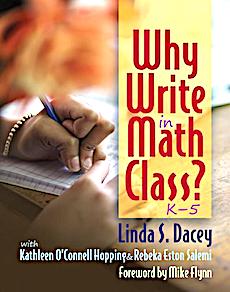The Power of Writing for Young Math Students
Why Write in Math Class? K-5
By Linda Dacey with Kathleen O’Connell Hopping and Rebeka Eston Salemi
(Stenhouse Publishers, 2018 – Learn more)

As an educator who has revamped her teaching in the subject area of math, I was grabbed by the title of this book. Recently, I’ve begun incorporating more writing into other subject areas. Math at first seemed questionable but then became a necessity.
As I began to read Why Write in Math Class? K-5, I envisioned my students and how they responded when I began using this approach. What I have really enjoyed in this book are the many examples given, as well as the collaboration we see among teachers that is evident throughout.

The title itself provides a great overarching question. In the introductory pages, Linda Dacey credits the authors of Types of and Purposes for Elementary Mathematics Writing: Task Force Recommendations for identifying the overarching goals “for students to reason mathematically and to communicate ideas.” (Casa et al. 2016.4)
Repurposing ELA’s types of writing
The four types of writing usually taught in the English Language Arts classroom – exploratory, informative/explanatory, argumentative, and creative – can also be used in math lessons, simply repurposed. Dacey devotes five chapters in the book to helping teachers focus on using these four types explicitly in math. I found these chapters extremely helpful.
As an intermediate teacher, I also found it interesting to learn more about the use of writing in the primary grades. I thought about how valuable this practice is in the early stages of learning math. As a foundation, it provides an engaging way for students to express their thinking.
I was particularly drawn to chapter two, “Developing a Community of Math Writers,” where Dacey discusses how “this practice has strengthened students’ conceptual understanding and their ability to view themselves as mathematicians” (page 9). I also appreciated the comparison between what we ask our students to do in a writing workshop (such as using the steps of the writing process) to what writing may look like in math. I was in total agreement with Dacey’s statement:
“It is the students who are eventually in charge of what is written on the paper, how they engage in the writing process, and how they will respond to feedback received from others. We need to believe and help students believe that they can craft their own math narratives” (page 15).
From exploration to explanation
In chapter four, “Writing to Explore,” Dacey describes how learners can explore new thinking by looking at others’ writing. I found myself nodding my head in agreement as Dacey provided a fourth grade example of a student working out a fraction word problem by drawing a picture, or “mapping,” and the idea of simply asking, ”What do you know?”
In Darcy’s example, as students worked on the same problem their teacher noticed the many differences in the drawings and maps. The next day the students were given others’ work so they could analyze and comment on it, offering suggestions, and also compare the other work to their own response. There is a dialogue provided between two of the students that demonstrates the level of engagement and understanding that occurs (pp 58-63).
Chapter five, “Writing to Describe and Explain,” delves into explanatory writing. I believe this is one of the most important reasons to use writing in math. It allows students to explain their thinking, which is a great window into their understanding. Dacey points out that “Years ago, math problems often ended with Show your work. Today, it is more common to see Explain your thinking” (page 68).
I have found in my own classroom that using the word “explain” engages the student to identify key words and numbers that helped them problem solve. Explanatory writing is procedural, and as Dacey states,
“Allocating time in the middle of a series of lessons or unit for students to write about a procedure, strategy, or concept gives them a powerful way to make their thinking explicit and for teachers to gain important formative assessment data” (page 73).
Inviting creativity to math class
Finally, I connected with chapter seven, “Writing to Connect Mathematics and Creativity.” This is an area that I have applied in my own math classroom. On page 114 Dacey offers a “Word problem writing template” that students can use to create a word problem. Examples of students’ completed templates are offered and truly demonstrate each student’s thinking process. “Connections to Literature” offers ways to motivate students to write creatively in math (page 117). The ideas Dacey and her co-authors share incorporate using familiar stories and changing key details to create a math story.
I came across this title as I was beginning to incorporate more writing into my 5th grade math class. Dacey writes, “When teachers are excited about writing in mathematics and show students how it is beneficial, both in the moment and over time, their students get excited too” (page 151). I couldn’t agree more!
Kathleen Palmieri is a National Board Certified Teacher and a fifth grade teacher in upstate New York who reviews regularly for MiddleWeb. With a passion for literacy and learning in the classroom, she participates in various writing workshops and curriculum writing endeavors. As a lifelong learner, she is an avid reader and researcher of educational practices and techniques. Collaborating with colleagues and globally on Twitter @Kathie042500 is an ongoing practice.




























